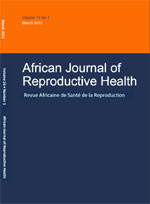
|
African Journal of Reproductive Health
Women's Health and Action Research Centre
ISSN: 1118-4841
Vol. 20, No. 3, 2016, pp. 208-117
|
 Bioline Code: rh16049
Bioline Code: rh16049
Full paper language: English
Document type: Research Article
Document available free of charge
|
|
|
African Journal of Reproductive Health, Vol. 20, No. 3, 2016, pp. 208-117
| en |
Trends in Health Facility Births in sub-Saharan Africa: An Analysis of Lessons Learned under the Millennium Development Goal Framework
Udo, Ifeyinwa E. & Doctor, Henry V.
Abstract
Sub-Saharan Africa (SSA) has the highest maternal and under-5 mortality rates as well as low facility births, with a high percentage of births occurring in the absence of skilled personnel. We examine trends in health facility births in SSA by geographic areas (urban-rural) and regions; and also the correlation between health facility birth and neonatal mortality rate (NMR). Data come from Demographic and Health Surveys (27 countries), conducted between 1990 and 2014. Median health facility births, urban-rural gaps, and regional variations in health facility births between initial (1990) and latest (2014) surveys were calculated. The median health facility birth increased from 44% at initial survey to 57% at the latest survey. Rural areas had a higher percentage increase in health facility births between initial and latest surveys (16%) than urban areas (6%) with a 2% overall gap reduction between initial and latest surveys. Health facility births were inversely associated with NMR at initial (R2=0.20, p=0.019) and latest (R2=0.26, p=0.007) surveys. To achieve the Sustainable Development Goal target of reducing neonatal mortality, policies should particularly focus on bringing rural areas on par with urban areas.
Keywords
Skilled birth attendants; maternal mortality; infant mortality; neonatal mortality; health facility birth
|
| |
© Copyright 2016 - African Journal of Reproductive Health
Alternative site location: http://www.ajrh.info
|
|
